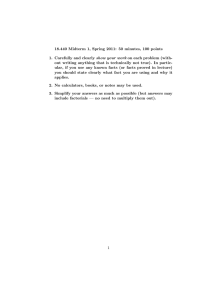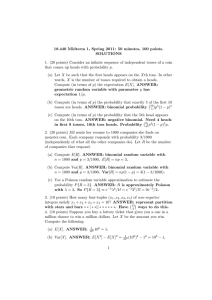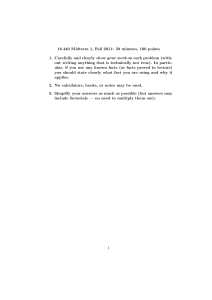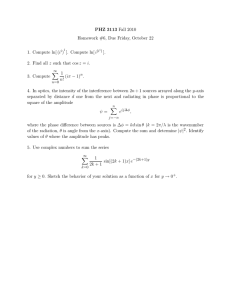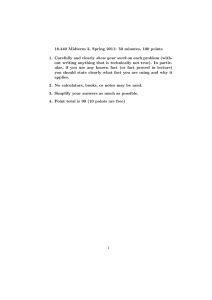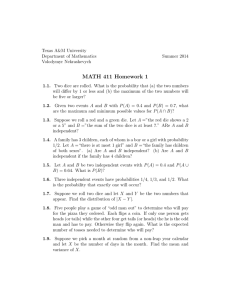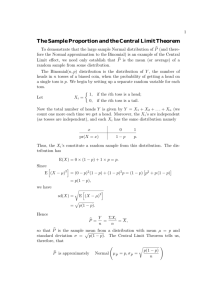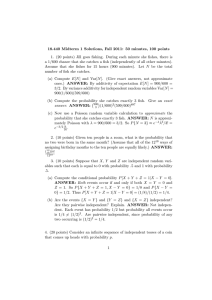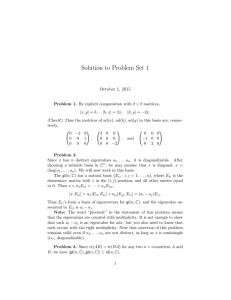18440: Probability and Random variables Quiz 1 Friday, October 17th, 2014
advertisement
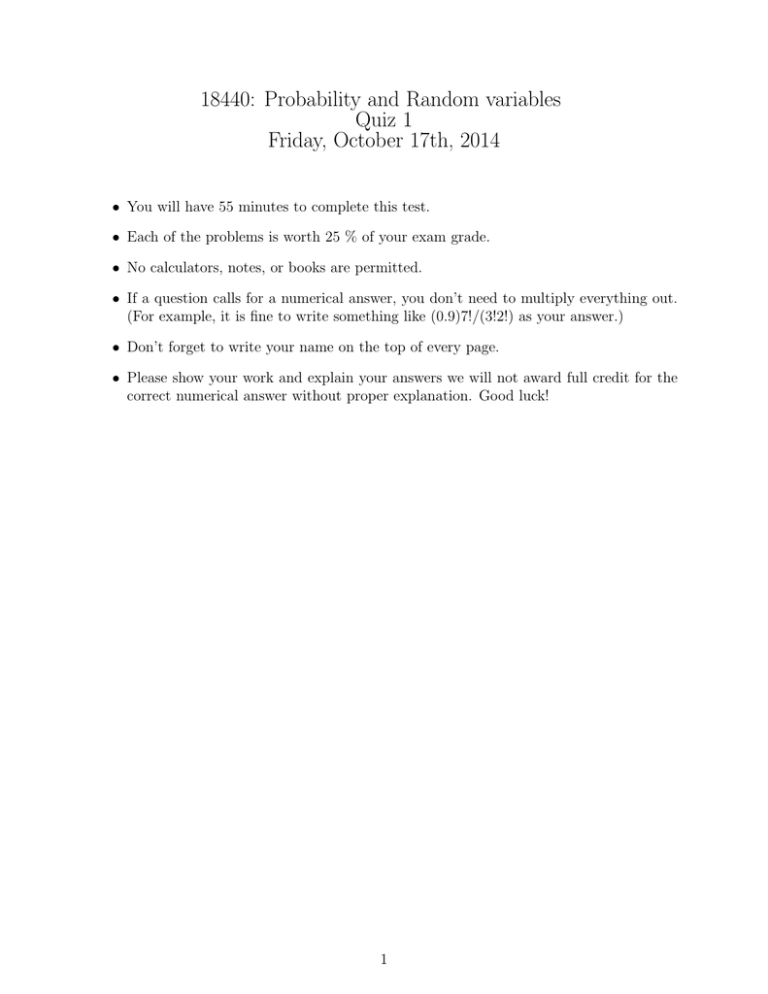
18440: Probability and Random variables
Quiz 1
Friday, October 17th, 2014
• You will have 55 minutes to complete this test.
• Each of the problems is worth 25 % of your exam grade.
• No calculators, notes, or books are permitted.
• If a question calls for a numerical answer, you don’t need to multiply everything out.
(For example, it is fine to write something like (0.9)7!/(3!2!) as your answer.)
• Don’t forget to write your name on the top of every page.
• Please show your work and explain your answers we will not award full credit for the
correct numerical answer without proper explanation. Good luck!
1
Problem 1 (35 points) A fair coin is tossed infinitely many times.
1. (3 points) What is the probability that the outcome of the first 2N tosses is N heads
followed by N tails.
2. (3 points) What is the probability of having exactly k heads among the N first tosses
?
3. (4 points) Compute the probability that the first head appears at the nth toss.
4. (10 points) Let T be the first toss when a head appears. Compute E[T ] and V ar(T ).
5. (15 points) Let Qn denote the probability that no run of 3 consecutive heads appears
in n tosses of a fair coin. Show that
1
1
1
Qn = Qn−1 + Qn−2 + Qn−3
2
4
8
by conditioning on the first tail. Compute Q6 .
Proof. 1. Let Hi and Ti be the events that i-th toss resulted in heads and tails respectively.
Then the probability is
P (H1 , ..., HN , TN +1 , ..., T2N ) = P (H1 )P (H2 )...P (HN )P (TN +1 )...P (T2N ) = (1/2)2N .
2. Let A be the event of having exactly k heads among the first N tosses. Let Ck be the
number of ways to positions k heads in first N tosses. Then we have
P (A) =
where Ck =
N
k
1
Ck ,
2N
if k ≤ N and 0 otherwise.
3. The above is precisely
P (T1 , ..., Tn−1 , Hn ) = P (T1 )...P (Tn−1 )P (Hn ) = (1/2)n .
4.The random variable T has the geometric distribution with probability p = 1/2. Thus
one concludes
1 − 1/2
E[T ] = 2 V ar(T ) =
= 2.
(1/2)2
See Examples 8b and 8c from Chapter 4 in Ross for details.
5. Let Ein be the event there are no 3 consecutive heads in tosses i + 1, ..., n . Then one
has
Qn = P (E0n ) = P (E0n |T1 )P (T1 ) + P (E0n |H1 , T2 )P (H1 , T2 ) + P (E0n |H1 , H2 , T2 )P (H1 , H2 , T2 )+
P (E0n |H1 , H2 , H3 )P (H1 , H2 , H3 ) =
1
1
1
1
1
1
= P (E1n ) + P (E2n ) + P (E3n ) = Qn−1 + Qn−2 + Qn−3
2
4
8
2
4
8
2
Then we have Q3 = 7/8, Q2 = Q1 = 1, which implies consecutively
Q4 = (1/2)(7/8) + (1/4) + (1/8) = 13/16,
Q5 = (1/2)(13/16) + (1/4)(7/8) + (1/8) = 24/32 = 3/4,
Q6 = (1/2)(3/4) + (1/4)(13/16) + (1/8)(7/8) =
3
24 + 13 + 7
44
11
=
= .
64
64
16
Problem 2 (10 points) One tosses a fair coin 3 times and denote Xi the random variable
which is equal to 1 if the ith toss is head, and zero otherwise.
• Compute P (X1 + X2 + X3 = 1|X1 − X2 = 0)
• Are the events {X1 = X2 }, {X2 = X3 }, {X3 = X1 } pairwise independent? independent? Explain.
Proof. One observes the equality of events
E = {X1 + X2 + X3 = 1, X1 − X2 = 0} = {X1 = 0, X2 = 0, X3 = 1} and
F = {X1 − X2 = 0} = {X1 = 1, X2 = 1} ∪ {X1 = 0, X2 = 0}
Thus
P (X1 + X2 + X3 = 1|X1 − X2 = 0) =
1/8
1
P (E)
=
= .
P (F )
1/2
4
Let A1 = {X2 = X3 }, A2 = {X1 = X3 }, A3 = {X1 = X2 } Then
P (Ai ) = P (F ) =
1
1
and P (Ai ∩ Aj ) = P (X1 = X2 = X3 ) = ,
2
4
which proves pairwise independence.
We observe
P (A1 ∩ A2 ∩ A3 ) = P (X1 = X2 = X3 ) =
1
1
6= = P (A1 )P (A2 )P (A3 ),
4
8
which proves the three events are not independent. This is fairly clear, since if we know
A1 and A2 occurred then we know that A3 occurred as well, so it is not independent from
them.
4
Problem 3 (10 points) Compute how many quintuple (x1 , x2 , . . . , x5 ) of non-negative
integer numbers so that
x1 + x2 + · · · + x5 = 30
Proof. This is essentially Proposition 6.2 in Chapter 1 of Ross’s “A First Course in Probability” with n = 30 and r = 5. So the answer is
n+r−1
34
34 · 33 · 32 · 31
= 46376.
=
=
1·2·3·4
r−1
4
Here is one (combinatorial) proof of the above: We consider a sequence of 34 boxes.
···
Then we color 4 of the boxes in black. This leaves 30 white boxes and splits the group of 30
boxes into 5 subgroups of non-negative size x1 , x2 , x3 , x4 , x5 . For example
···
corresponds to x1 = 1, x2 = 1, x3 = 1, x4 = 2, x5 = 25, and
···
corresponds to x1 = 0, x2 = 1, x3 = 0, x4 = 2, x5 = 27.
More generally, let the boxes be placed on positions 1, 2, 3, · · · 34 and let the colored
boxes be in positions i1 , i2 , i3 , i4 . Then we have x1 = i1 − 1; x2 = i2 − i1 ; x3 = i3 − i2 ; x4 =
i4 − i3 ; x5 = 34 − i4 . Then one observes that each choice of 4 boxes to color gives in the
above way a distinct 5-tuple (x1 , x2 , . . . , x5 ), satisfying our problem and in fact this is a
bijective correspondence. This means that the numberof 5-tuples (x1 , x2 , . . . , x5 ) is exactly
the number of ways to choose 4 boxes from 34, i.e. 34
.
4
5
Problem 4 (15 points) Take 100 men and assume their birthdate is independent, equally
distributed on {1, 2, . . . , 365}. Let X be the number of men with birthdate on april 1.
Compute E[X] by exact computation and then approximate the probability that {X ≤ 3}
by using the Poisson approximation.
P
Proof. Number the men from 1 to 100. We know X = 100
i=1 Xi , where Xi = 1 if man i
was born on April 1, and 0 otherwise. We observe Xi are independent Bernoulli random
variables with probability p = 1/365. Thus
E[X] =
100
X
i=1
100
X
100
20
1
=
= .
E[Xi ] =
365
365
73
i=1
We observe that the number of people born on April 1 has the binomial distribution with
1
parameters (p, n) = ( 365
, 100). Thus we may approximate the distribution by P oisson(np) =
100
P oisson( 365 ). Then
P ({X ≤ 3}) ≈ e−λ (1 + λ + λ2 /2 + λ3 /6),
where λ = 20/73.
6
Problem 5 (25 points) Roll 6 dice independently.
1. (10 points) Find the probability that that there are at least 4 sixes given that there is
at least one.
2. (15 points) Let X be the number of ways of couple of dice that have the same value (if
they all have the same value, X = 6×5/2). Compute E[X] and V ar(X). Hint: decompose X by considering the indicator functions of the sets Eij = {ith dice equals j th }.
Proof. (1)Let Ei be the event there are i sixes. Then we have the desired probability is
P (∪6i=4 Ei | ∪6i=1 Ei ) =
P (∪6i=4 Ei , ∪6i=1 Ei )
P (∪6i=4 Ei )
=
.
P (∪6i=1 Ei )
P (∪6i=1 Ei )
We have
P (∪6i=1 Ei ) = 1 − P (E0 ) = 1 − (5/6)6 ,
P (∪6i=4 Ei ) = P (E4 ) + P (E5 ) + P (E6 ) = 15 ×
5
1
375 + 30 + 1
52
+
6
×
+
1
×
=
.
66
66
66
66
Thus we conclude
P (∪6i=4 Ei | ∪6i=1 Ei ) =
406
66 − 56
(2)We will use the hint. Let us number our dice from 1 to 6. Then let Eij be random
variables that equal 1 if the value of die i is the same as that of die j. Then we have
X=
6 X
6
X
Eij .
i=1 j<i
We then observe Eij are Bernoulli random variables with parameter 1/6 (if j < i). Thus
E[Eij ] = 16 and we get
X
6
1
j
= 2.5
E[X] =
E[Ei ] = ×
2
6
j<i
We have
V ar(X) = E[X 2 ] − E[X]2 ,
so it suffices to compute E[X 2 ]. We have
X jX
XX
E[Eij Ekl ].
E[X 2 ] = E[
Ei
Ekl ] =
j<i
j<i l<k
l<k
We now have that E[Eij Ekl ] = 1/6 if i = k and j = l and 1/36 otherwise. There are
2
summands of the first type and 62 − 62 of the second so we get
2 1 6
1 6
6
15 210
300
25
2
E[X ] =
+ (
−
)=
+
=
= .
6 2
36 2
2
6
36
36
3
We conclude that
V ar(X) =
25 25
25
−
= .
3
4
12
7
6
2

